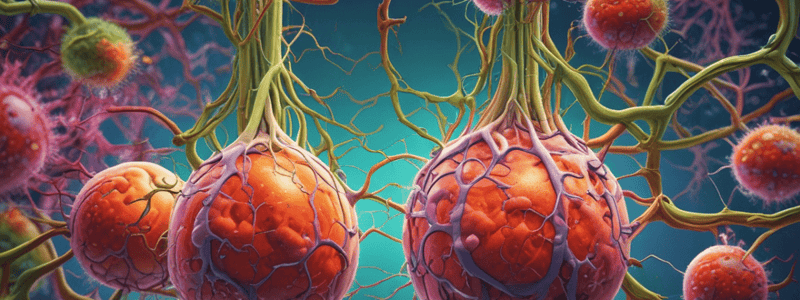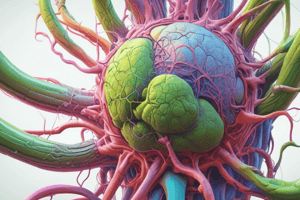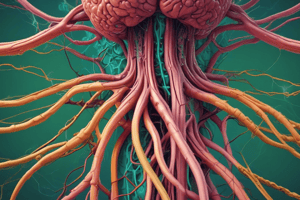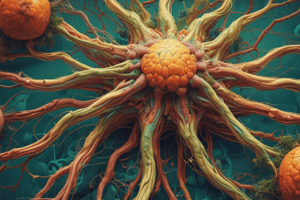Podcast
Questions and Answers
What happens when a B cell attaches to an antigen?
What happens when a B cell attaches to an antigen?
- The B cell secretes antibodies
- The B cell differentiates into a plasma cell (correct)
- The B cell becomes a T cell
- The B cell is destroyed
What is the primary function of T cells?
What is the primary function of T cells?
- To destroy cells infected with intracellular pathogens
- Both a and b (correct)
- To secrete chemokines and bring other immune cells to the area
- To produce antibodies
Where do B cells develop?
Where do B cells develop?
- Spleen
- Bone marrow (correct)
- Lymph nodes
- Thymus
What is the primary function of Natural Killer cells?
What is the primary function of Natural Killer cells?
What happens to the thymus gland over time?
What happens to the thymus gland over time?
What is the main function of the lymphatic system?
What is the main function of the lymphatic system?
What is the major staging area for the development of a critical immune response?
What is the major staging area for the development of a critical immune response?
How does lymph move through the body?
How does lymph move through the body?
Which cells coordinate the adaptive immune response?
Which cells coordinate the adaptive immune response?
Where do all leukocytes originate from?
Where do all leukocytes originate from?
Which immune response is rapid but non-specific?
Which immune response is rapid but non-specific?
What is the function of lymph nodes in the lymphatic system?
What is the function of lymph nodes in the lymphatic system?
Which organ is described as having extensive vascularization and is known as the 'filter of the Blood'?
Which organ is described as having extensive vascularization and is known as the 'filter of the Blood'?
What type of cells are mainly found in lymphoid nodules?
What type of cells are mainly found in lymphoid nodules?
What causes the swelling of tonsils?
What causes the swelling of tonsils?
Which vessels enter the lymph nodes?
Which vessels enter the lymph nodes?
Where is Mucosa-associated lymphoid tissue (MALT) mainly found?
Where is Mucosa-associated lymphoid tissue (MALT) mainly found?
What is the primary function of bronchus-associated lymphoid tissue (BALT)?
What is the primary function of bronchus-associated lymphoid tissue (BALT)?
Which of the following is NOT a barrier defense mechanism?
Which of the following is NOT a barrier defense mechanism?
What is the primary role of macrophages in the innate immune response?
What is the primary role of macrophages in the innate immune response?
Which of the following is a key function of the complement system?
Which of the following is a key function of the complement system?
What is the primary purpose of the inflammatory response?
What is the primary purpose of the inflammatory response?
What is the key difference between the primary and secondary adaptive immune responses?
What is the key difference between the primary and secondary adaptive immune responses?
What is the key difference between class I and class II MHC molecules?
What is the key difference between class I and class II MHC molecules?
What is the primary function of natural killer (NK) cells in the innate immune response?
What is the primary function of natural killer (NK) cells in the innate immune response?
What is the primary function of pattern recognition receptors (PRRs) in the innate immune response?
What is the primary function of pattern recognition receptors (PRRs) in the innate immune response?
What is the primary function of interferons in the innate immune response?
What is the primary function of interferons in the innate immune response?
Which cells present antigens to T cells in the lymph nodes?
Which cells present antigens to T cells in the lymph nodes?
What is the process that eliminates self-reactive T cells during T cell development?
What is the process that eliminates self-reactive T cells during T cell development?
What is the primary function of helper T cells?
What is the primary function of helper T cells?
Which type of helper T cell regulates the activity of B cells?
Which type of helper T cell regulates the activity of B cells?
What is the process by which a single T cell recognizes an antigen and rapidly divides into many effector and memory T cells?
What is the process by which a single T cell recognizes an antigen and rapidly divides into many effector and memory T cells?
Which type of T cell directly kills infected or cancerous cells?
Which type of T cell directly kills infected or cancerous cells?




